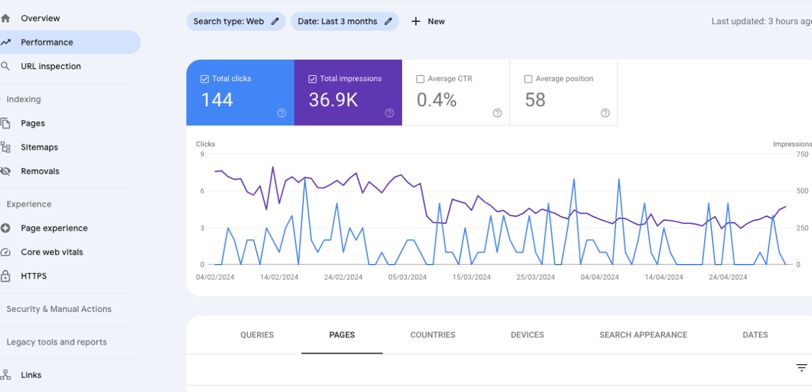How to update old blog posts for SEO?
In this blogpost we will take you on a walk to reveal the secrets about the importance of rewriting old blog posts and best practices on how to update old blogs for SEO.
Iqra Abid
7/19/20248 min read


I have a quick question for all business owners and marketing professionals. Do you do anything with the blog posts that you published a year or months ago?
I am 99% sure that the first thought to all of you about this question is like nothing. We do nothing to any existing content. And that’s where the decline in organic traffic and Google rankings can take birth.
Big marketers like Neil Patel even repurpose or republish their old content despite the fact he is authoritative enough to not lose search engine rankings.
Then why this factor is so underrated? Because everyone is obsessed with publishing new blog posts on fresh industry topics and trends and neglects this goldmine.
Today I am going to take you on a walk to reveal the secrets about the importance of rewriting old blog posts and best practices of how to update old blogs for SEO.
Why does updating old blog posts matter?
Studies demonstrate the unquestionable impact of content creation. According to HubSpot data, firms that prioritize blogging achieve a 67% better return on investment (ROI) from their marketing efforts.
However, just owning a blog is not enough. According to Search Engine Journal, if your content is not updated, organic traffic can drop by 50% within a year.
So, it’s clear that updating or republishing the old content matters and can reduce the organic traffic if it isn’t done at the time.
Recommended: Does repurposing content work?
Several reasons contribute to this reduction
The Algo Aunty
Yes, I am talking about the search engine rapidly changing algorithms ASAP Google. The algorithms always prioritize the updated content over the old content. If you don’t update old blogs, sooner or later they will not serve in the SERPs.
Stay with the trends
Every industry has its own trends especially marketing is the most evolving place, what works today might not work tomorrow. So, keep walking with the industry trends by updating the old content. It can build your business as an authority among the audience.
Also coming up with new ideas sometimes is tiring. Updating old blogs can overcome this scenario.
Stats and broken links
Stats are changing yearly or even monthly. What you mentioned in your old blog post might not be the same numbers today. Broken or dead links also redirect the user to 404 errors which also decline the user experience and organic traffic.
How to update old content. Best practices
1. How do I choose which blog to update?
The beginning of updating or republishing the old blog posts starts with identifying the blogs that can work for you.
If we categorize the blogs that need to be updated then blog posts that are in the 11 to 27 position, possibly on the 2nd or 3rd page of search engines should be updated and optimized first.
Because they definitely have potential and can be optimized for first-page ranking. It's just like you need to pull the low-hanging fruit a bit more.
Besides these, blog posts that were performing well for you but now losing traffic can also be optimized and republished.
Google Search Console is a free tool that every website owner should utilize. Through this tool, you can identify which blog posts were performing better for attracting organic traffic and how much is now a decline.
Check metrics like the number of clicks, impressions, and position of the blog posts by adjusting the date and month. In this way, you can learn about the performance of the last 3 to 6 months.


In the above picture, you can see the overview of the GSC. On the top is the tab where you can adjust the date to compare the matrices of 3 months and decide the pages that need updating.
Bonus tip
GSC also offers a dedicated "Search Results" section. Here, you can explore specific keywords your website ranks for and see how individual blog posts perform for those keywords.
Look for posts that once ranked well for relevant keywords but have dropped in position. This can indicate outdated information or a need for content optimization.
A must-read: How to conduct an SEO audit? Step-by-step guide.
2-Prioritize the blogs for a bigger impact.
When you have the data about all pages now prioritize the updating of one that was playing a significant role in getting traffic and now is declining. With a strategic refresh and republishing those pages will again reach their glory.
However, if your goal is to increase sales and leads, then focus on commercial pages like pricing, products, services, and landing pages.
Although these pages don’t have more traffic than other educational blog posts but still their republishing can make a difference.
3- Rewriting the content
Now is the actual part of updating. No doubt it seems crushing to update the different portions of the blog post but it's crucial for SEO.
Review stats and facts and make sure they are updated. Which content section has repetitive material? Which portion lacks keyword optimization? Which portions are less engaging and do not provide value?
By identifying all these holes in your content bucket, you can rewrite those portions and reoptimize your content.
If you are already feeling daunted, then sit back and be calm as a cucumber. With AI tools and AI-trained virtual assistants, all can be done with less amount of time and money.
Recommended reading: How virtual assistant can save you time and money?
Related: How to keep the human touch in AI-generated content?
4- Reconduct the keyword research
Updating the old blog posts for SEO also includes identifying the terms and keywords by which your audience searches the relevant topic. It's like their search intent may be different for now. Months ago, they searched a topic with different keywords and now they search it with different terms.
For example,
Suppose you created a blog post about "remote work productivity tips" a year ago. At the time, your target audience may have looked for keywords like "remote work productivity hacks" or "how to stay focused while working from home.”
However, as the remote work world evolves, so will your audience's search behavior. People are no longer just looking for generic advice; they want specific answers to frequent difficulties they find in remote work environments.
Conducting keyword research and analyzing search trends reveals that terms such as "virtual collaboration tools," "work-from-home ergonomics," and "mental health tips for remote workers" are becoming increasingly popular.
It shows a shift in search intent toward more specific information about remote employment.
Related: Why should you hire an SEO virtual assistant?
5- Rewrite headings and meta tags
To update the old blog post for SEO, you can also renovate the headings and meta tags of the blog and make them more optimized. Including the keywords in the headings can improve the optimization of the page. Also, search engines can better understand the topic.
Here the tip for you is that you need to remember that you are rewriting the headings, meta titles, and descriptions for humans and robots. While humans going to read this, robots going to decide whether to show them in the SERP or not.
So, your titles and headings are attractive and optimized in the eyes of both.
You can check your previous click-through rate of the blog post and get to know how good was your meta tag, descriptions, and headings. If your organic CTR is around 3 to 5%, then it’s a good symbol.
While with less CTR, you should update the meta tags and descriptions.
Related: SEO Best Practices. 9 most effective techniques.
6- Reoptimize your pages
Sometimes increasing the number of keywords that you are targeting on a specific page can increase the chances of appearing on SERP and can optimize your blog post.
By adding keywords and LSI terms (phrases that are related to the primary keywords or you can say the synonyms of the primary keyword) you can update the old blog post in a more optimized way.
While updating the existing blog post, also add a clear call to action to your page so that readers are clear about what they are supposed to do. You can mention your product or service twice in a blog.
However, discussing more about you and less about solving the problem of the audience may divert their interest in your content.
7- Update the old information
The keystone of updating the old blog posts for SEO is to identify outdated information.
It may include any new industry trends and best practices to solve any problem.
For example, there is a topic about Instagram organic reach boosters. Reels and video materials are now the real boosters in Instagram marketing.
So, if you didn’t mention information and stats related to this, then you are lacking the trending information in your blog post.
Moreover, you should revisit your intro and conclusion of the blog posts to pack it in a well-organized way.
Recommended: How often should you update your content in 2024?
8- Expand or brief the ideas for updating the blog content
While updating a blog for SEO, check whether your point needs to be explained more with examples or if they need to be closed concisely.
Some points of view definitely require examples while some are so clear that they don’t need wordy explanations. So when you are rewriting the blog post for SEO, check these sections and make modifications accordingly.
Recommended: How to write a good SEO blog? 10 unique ways to get ranked.
9- Improve visuals and other media for SEO
In modern digital marketing, visuals and videos are the real appeal to everyone otherwise your content looks boring.
Updating the old visuals and videos with fresh designs and information, make your blog post more appealing.
Visuals are helpful to enhance the user experience and readability of the content as they break the text into different sections.
Plus updating the old images with new refreshed branding styles and logos can give a new appeal
10- Warning: Don’t change the URL
It’s the best practice to not change or update the URL of the blog post that you want to update. It helps to prevent potential confusion and preserve the authority of the page.
While updating old content for SEO, if you really want to change the URL, then redirect the users to other new posts.
Here the most important thing that should be considered as a warning that also update the publish date of your blog posts. It shows to the eyes of the readers that your content is UpToDate.
Another thing that most marketers neglect is that after updating the blog post, they don’t check whether Google robots come and crawl your updated blog. If this doesn’t happen eventually, then do send crawl requests to search engines.
11- Update the blog by adding internal links.
It's so natural that you are publishing new topics that are relevant to the old ones and can serve as clusters.
But at that time, you cannot link new pages to your blog. So, when you choose to update any blog post for SEO, don’t forget to add links to other relevant pages of the website.
It will not only boost the visibility of this old post but also enhance the optimization of those linked pages in the eyes of search engines.
Final thoughts: How to update old blog posts for SEO?
Updating the already researched and optimized content can be daunting for anyone. But this is the habit that every business owner and marketing professional should develop to increase organic traffic and get the most out of the existing content of the website.
Here's one final tip to all of you, divide your efforts properly. You should give 50% to updating the old blogs and 50% percent to new content publications. Or you can vary according to your SEO goals and content marketing objectives.
But the mix of both updating and publishing new content can work for all of you. So, remain consistent and efficient in your SEO game.
And if you’d like help in auditing and updating your existing blog posts, don’t hesitate to get in touch with the Vaforus.

